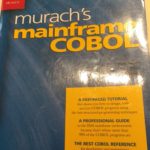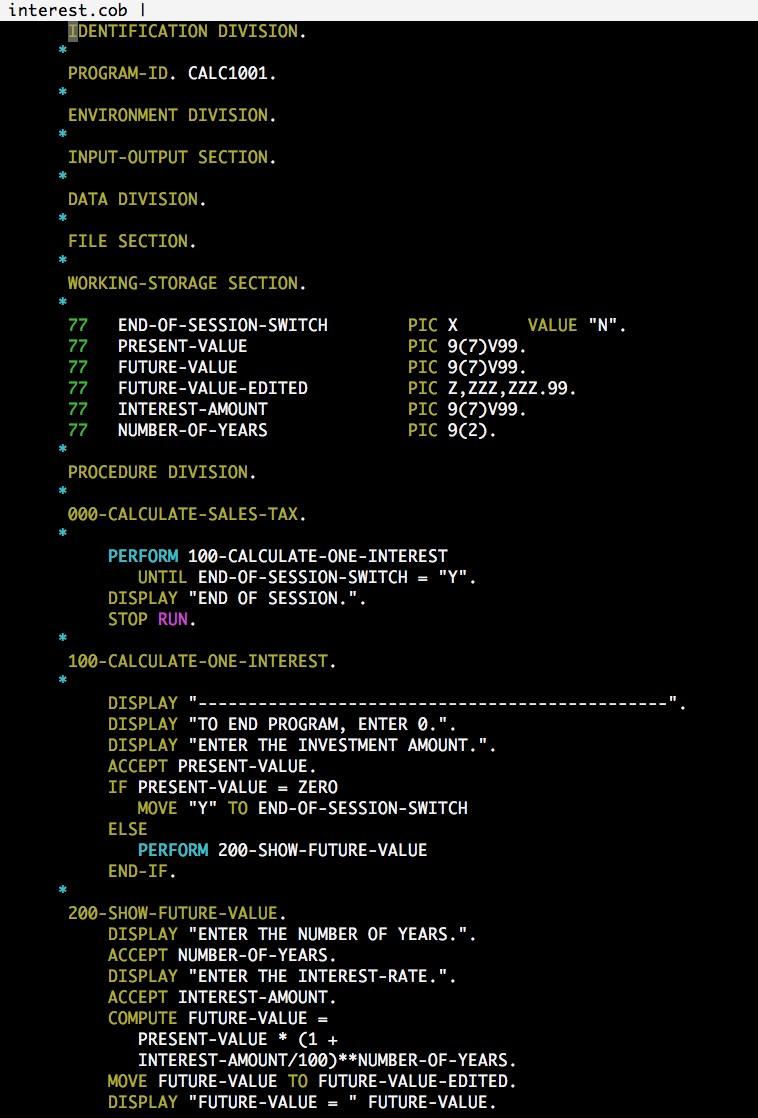In code that I am writing for work, I’m calling into COBOL code from C, and in order to setup the parameters and interpret the results, I have to know a little bit about how variables are declared in COBOL. I got an explanation of a little bit of COBOL syntax today that takes some of the mystery away.
Here’s the equivalent of something like a declaration of compile time constant variables in COBOL, a hierarchical beast something akin to a structure:
004500 01 CONSTANT-VALUES. ORIG_SRC
004600 02 AN-CONSTANT PIC X(5) VALUE "IC104". ORIG_SRC
004700 02 NUM-CONSTANT PIC 99V9999 VALUE 0.7654. ORIG_SRC
This is roughly the equivalent of the following pseudo-c++11:
struct
{
char AN_CONSTANT[5]{'I','C','1','0','4'};
struct {
char digits1[2]{'0', '0'};
char decimalpoint{ '.' };
char digits2[4]{'7', '6', '5', '4'};
} NUM_CONSTANT;
} ;
Some points:
- The first 6 characters are source sequence numbers. They aren’t line numbers like in BASIC (ie. you wouldn’t do a ‘goto 004500’), but were related to punch cards to make sure that out of sequence cards weren’t inserted into the card reader, or a card wasn’t fed into the reader by the operator by accident.
- The ‘ORIG_SRC’ stuff in column 73+ are ignored. These columns are also related to punch cards, as an additional card sequence number could be encoded in those locations.
- The 01 indicates the first level of the ‘structure’.
- The 02 means a second level. I don’t know if the indenting of the 01, 02 is significant, but I suspect not.
- PIC or PICTURE basically means the structure line is a variable and not the name of a new level.
- A sequence of 9’s means that the variable takes numeric digits in those locations, whereas the V means that location is a period.
- A sequence of X’s (or the X(5) here that means XXXXX), means that those characters can be alphanumeric.
- There is no reference to ‘CONSTANT-VALUES’ when the variables are referenced. That is like a namespace of some sort.
- The level indicators 01, 02 are arbitrary, but have to be less than 77 (why that magic number? … who knows). For example 05, 10 could have been used, so that another level could have been inserted in between without renumbering things.
The 01, 02 level indicators are also used for global variable declarations, also somewhat struct like:
004900 01 GRP-01. ORIG_SRC
005000 02 AN-FIELD PICTURE X(5). ORIG_SRC
005100 02 NUM-DISPLAY PIC 99. ORIG_SRC
005200 02 GRP-LEVEL. ORIG_SRC
005300 03 A-FIELD PICTURE A(3). ORIG_SRC
This might be considered equivalent to:
struct
{
char AN_FIELD[5];
char NUM_DISPLAY[2];
struct {
char A_FIELD[3];
} GRP_LEVEL;
} GRP_01;
Here:
- A(3), equivalent to AAA, means the field can have ASCII values.
- The name ‘GRP-LEVEL’ header for the 03 structure level is not referenced in the code.
It is also possible to declare a variable as binary, like so:
005400 77 ELEM-01 PIC V9(4) COMPUTATIONAL. ORIG_SRC
- Here 77 is a special magic level number, that really means what follows is a variable and not a “structure”.
- The V here means an implied decimal place in the interpretation of the value.
- The 9(4), equivalent to 9999, means the variable must be able to hold 4 numeric digits.
- The COMPUTATIONAL means the underlying variable must be able to hold a value as big as 9999. i.e. a short or unsigned short must be used, and not a char or unsigned char.
The final variable group in the code I was looking at was:
005500 01 GRP-02. ORIG_SRC
005600 02 GRP-03. ORIG_SRC
005700 03 NUM-ITEM PICTURE S99. ORIG_SRC
005800 03 EDITED-FIELD PIC XXBX0X. ORIG_SRC
which is roughly equivalent to:
struct
{
struct {
char NUM_ITEM[2];
struct
{
char digits1[2];
char blank1[1]{' '};
char digits2[1];
char zero1[1]{'0'};
char digits3[1];
} EDITED_FIELD;
} GRP_03;
} GRP_02;
Here
- EDITED-FIELD includes fixed blank and zero markers (B, 0 respectively). When a four character variable is copied into this field, only the characters in the non-blank and non-zero values are touched.
- NUM-ITEM is a signed numeric value. It’s representation is strange:
The signed representation is also char based, and uses what is referred to as an “over-punch” to encode the sign. The normal (EBCDIC) encoding of a two digit variable 42 without a sign, would be:
‘4’, ‘2’ == 0xF4, 0xF2
when the S modifier is used in the PICTURE declaration, the F in the EDCDIC encoding range is changed to either C or D for unsigned and signed respectively. That means the ‘4’, ‘2’ is encoded as:
0xF4, 0xC2
whereas the signed value “-42” is encoded as:
0xF4, 0xD2
The procedure prototype, specifically, what the parameters to the function are, are given in a ‘PROCEDURE DIVISION’ block, like so:
005900 PROCEDURE DIVISION USING GRP-01 ELEM-01 GRP-02.
Here
- The first 6 characters are still just punch card junk.
- Three variables are passed to and from the function: GRP-01, ELEM-01, GRP-02. These are, respectively, 10, 4, and 8 bytes respectively.
- On the mainframe the COBOL function could be called with R1 something like:
struct parms {
void * pointers[3];
char ten[10];
uint16_t h;
char eight[8];
};
//...
struct parms p;
p.pointers[0] = &p.ten[0];
p.pointers[1] = &p.h;
p.pointers[2] = &p.eight | 0x80000000;
strncpy( p.ten, "XXXXX00ZZZ", 10 );
p.h = 0;
strncpy( p.eight, "99XXBX0X" );
setregister( R1, &p );
The 0x80000000 is the mainframe “31-bit” way of indicating the end of list. It relies on the fact that virtual memory addresses in 32-bit z/OS processes have only 31-bits of addressable space available, so you can hack one extra bit into a pointer to indicate end of list of pointers.
Suppose the program has statements like the following to populate its output fields
006400 MOVE AN-CONSTANT TO AN-FIELD.
006500 ADD 25 TO NUM-DISPLAY.
006600 MOVE "YES" TO A-FIELD.
006700 MOVE NUM-CONSTANT TO ELEM-01.
006800 MOVE NUM-DISPLAY TO NUM-ITEM.
006900 MOVE "ABCD" TO EDITED-FIELD.
The results of this are roughly:
strncpy( p.ten, "IC104", 5 ); // MOVE AN-CONSTANT TO AN-FIELD (GRP-01)
strcpy( p.ten + 5, "25", 2 ); // ADD 25 TO NUM-DISPLAY (GRP-01): since the initial value was "00"
strncpy( p.ten + 7, "YES", 3 ); // MOVE "YES" TO A-FIELD.
p.h = 7654 // MOVE NUM-CONSTANT TO ELEM-01.
strcpy( p.eight, "25", 2 ); // MOVE NUM-DISPLAY TO NUM-ITEM.
strncpy( p.eight + 2, "AB C0D", 6 ); // MOVE "ABCD" TO EDITED-FIELD.
It appears that the the assignment of NUM-CONSTANT, a number of the form 99.9999 to the numeric value ELEM-01 which is of the form .9999, just truncates any whole portion of the number.
Like this:
Like Loading...


